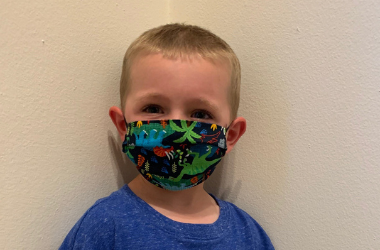Our kids are always watching us, mimicking our mannerisms and the way we speak—for better or for worse. In the case of COVID, though, it’s largely a good thing: Kids notice that you’re regularly taking a cleansing wipe to the remote and spending extra time washing your hands.
They also undoubtedly notice how often you’re wearing a mask. Currently, CDC guidelines say anyone over the age of two should wear a mask or cloth face covering to help slow the spread of COVID-19. For some kids, masking isn’t a big deal—in fact, they may ask to wear one simply because you’re doing it. Others might struggle, though, especially considering all the upheaval in their lives these last few months. Wearing a mask may be yet another uncomfortable change on a long list of uncomfortable changes.
From the beginning of the pandemic, experts advised that honest conversations with children about the consequences of COVID-19 were the best method for squashing undue anxiety. The same goes for wearing masks. Consider, for example, that many children may associate masks with sickness, so seeing tons of people wearing face  coverings all the time could make them particularly nervous. If your children are old enough, talk to them about how COVID-19 spreads from one person to another. Emphasize that wearing masks does not automatically equate to illness; on the contrary, wearing masks means we’re protecting ourselves from getting sick, and also protecting the people we love.
coverings all the time could make them particularly nervous. If your children are old enough, talk to them about how COVID-19 spreads from one person to another. Emphasize that wearing masks does not automatically equate to illness; on the contrary, wearing masks means we’re protecting ourselves from getting sick, and also protecting the people we love.
Along with frank conversations, the University of Michigan offers other tips to help your children adjust to wearing masks:
- Model good mask behavior. We should all be wearing masks when we’re in public, particularly when it’s not possible to socially distance. Masks should completely cover your nose, mouth, and chin. If your children are struggling with wearing the mask properly, find a mirror and practice with them.
- “Goldilocks and the Three Bears.” As you’re practicing, make sure the mask isn’t too big or too tight. Cloth masks are much more comfortable for children than surgical masks, but you still want to make sure they fit just right.
- Encourage children to choose their own mask. While we won’t be wearing masks forever, the requirement is not likely to go away any time soon. If the option is available to you, allow your children to choose masks with their favorite characters, or their favorite colors. The choice will give them some control over the situation—and may make them more eager to wear it.
- If necessary, consider a rewards system. However, if your kids are the opposite of eager to wear a mask, consider a rewards system to reinforce positive behavior. Use a sticker chart to encourage proper mask etiquette, and set goals with small rewards if your kids reach their goals.
Cloth masks should be washed after every use, so it may be helpful to have a number of them on-hand. Feel free to throw the masks in with a regular load of laundry and your usual detergent. Dry on high heat, or lay flat and allow to completely dry before wearing them again.
And a quick reminder for all of us practicing proper mask etiquette: We should be washing our hands often with soap and water for 20 seconds, especially because of how often we’re touching our face. If soap and water are not available, use an alcohol-based hand sanitizer with at least 60% alcohol.
Monday: 8 AM - 5 PM
Tuesday: 8 AM - 6 PM
Wednesday: 8 AM - 5 PM
Thursday: 8 AM - 5 PM
Friday: 8 AM - 5 PM
Lab Hours by appointment:
Monday - Friday:
7:30 AM - 4 PM
518-580-2099
Fax: 518-580-2098
